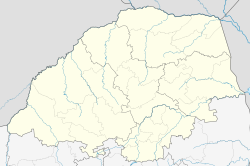Makumeke | |
|---|---|
| Coordinates: 22°58′52″S 30°38′02″E / 22.981°S 30.634°E | |
| Country | South Africa |
| Province | Limpopo |
| District | Vhembe |
| Municipality | Thulamela |
| Main Place | Thohoyandou |
| Area | |
| • Total | 0.99 km2 (0.38 sq mi) |
| Population (2011)[1] | |
| • Total | 1,429 |
| • Density | 1,400/km2 (3,700/sq mi) |
| Racial makeup (2011) | |
| • Black African | 99.8% |
| • White | 0.2% |
| First languages (2011) | |
| • Tsonga | 98.0% |
| • Other | 2.0% |
| Time zone | UTC+2 (SAST) |
Makumeke (Xitsonga, "one who is found") is a small village in the Thulamela local municipality, approximately 9 km (5.6 miles) from Malamlele Township in northern South Africa.
Geography
[edit]Makumeke is near or on five rivers: the large Rivhubye River, the intermittent river Ngholombi and rivulets Sanavi, Hlantswatindyelo, and Mitlhwari. The latter three flow through the community's north side.
Demographics
[edit]Makumeke has a population of 1,429 people based on the 2011 census.[1] The population is made up of 804 Females and 625 males. 99.79% of the population are Black African and 0.21% are white. The main language spoken here is Xitsonga.
Facilities
[edit]Makumeke consists of residences, a primary school, a daycare, a general store, a cafe and several spaza shops. The village has running water and electricity.
Economy
[edit]Makumeke suffers from high unemployment. Most of its families live below the poverty line.



Well, that’s interesting to know that Psilotum nudum are known as whisk ferns. Psilotum nudum is the commoner species of the two. While the P. flaccidum is a rare species and is found in the tropical islands. Both the species are usually epiphytic in habit and grow upon tree ferns. These species may also be terrestrial and grow in humus or in the crevices of the rocks.
View the detailed Guide of Psilotum nudum: Detailed Study Of Psilotum Nudum (Whisk Fern), Classification, Anatomy, Reproduction